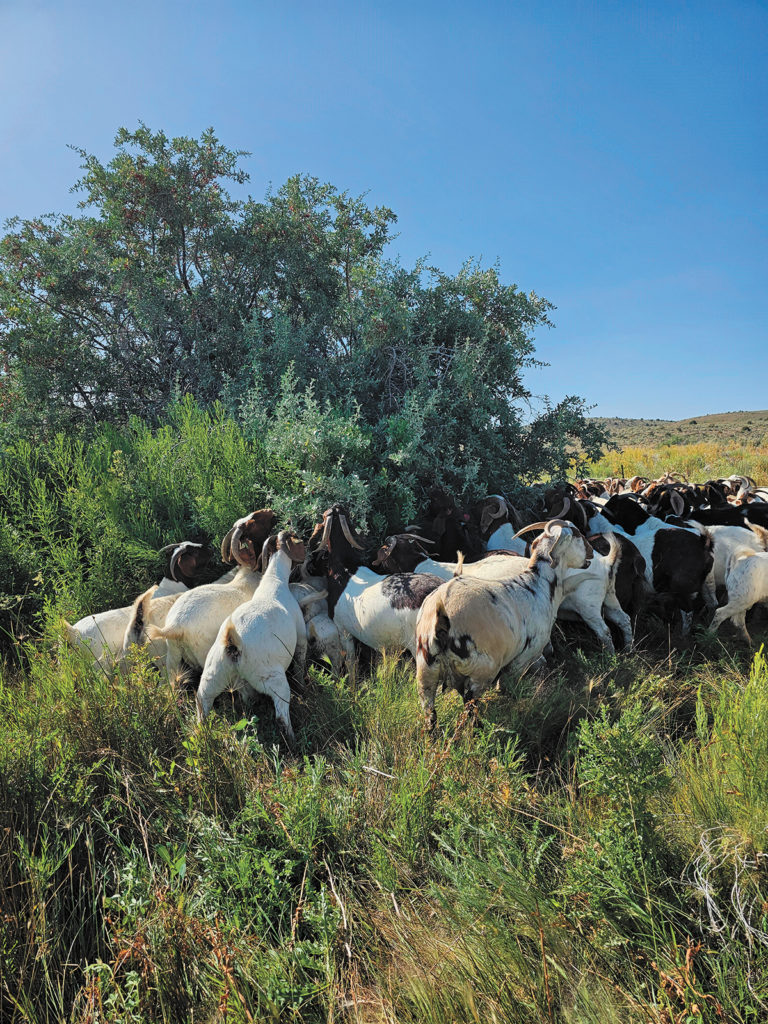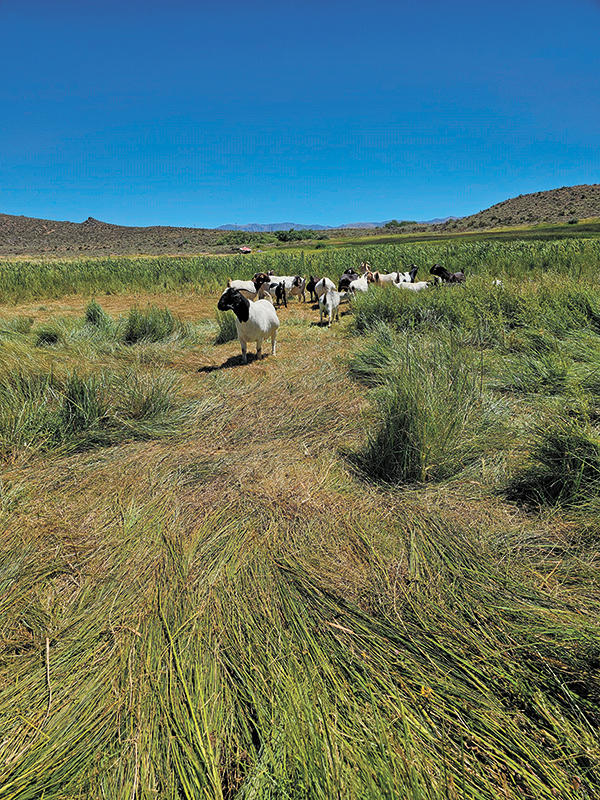The Symbiotic Union Of Weed Warriors And The United States Forest Service
Should anyone doubt the validity of precision grazing, known also as prescribed grazing and prescription grazing, one need only to turn to the United States Forest Service, Humboldt-Toiyabe National Forest, Carson Ranger District in Nevada and check in with either Courtney Ghiglieri, Rangeland Management Specialist, or with Brianna Kooreman, Sierra Zone Biological Technician (Invasive Plants). And then touch base in with Gloria Montero of Weed Warriors.
Courtney has been with the Forest Service for 15 years. She is knowledgeable about the District’s Noxious and Invasive Weeds Program which targets Lepidium latifolium (tall whitetop), Cardaria draba (hoary cress), and Cirsium arvense (creeping thistle), particularly at Mud Lake in Douglas County, NV, where, currently, goats are used as fuel reducers. Additionally, she and Brianna, who has been with the agency for 8 years, are familiar with the broader targeted efforts that are part of the District’s fine fuel’s reduction program utilizing sheep. Prescription grazing can be done with livestock, in general. Currently, the District has three active projects: West Carson (located in Carson City), Arrowhawk (located in Reno), and Jack’s Valley (located south of Carson City).
The Carson Ranger District is one of the first districts to incorporate targeted grazing in their fuel’s reduction program, starting with the West Carson project in 2006 working with Carson City Open Space. The program has expanded to incorporate State, private, and county lands. It has shaped a partnership with the University of Nevada to provide research.
For every problem, a solution awaits. Gloria Montero, owner and operator of Weed Warriors in Lovelock, NV, attended a local weed working group meeting in Douglas County, which led to her bidding on Mud Lake in 2010. She used her goats to control the weed population. Mud Lake was not her first project. Weed Warriors was born in 2007. That year, Gloria’s goats were utilized as a prescription grazing answer to a knapweed issue in Kings Canyon in Carson City.
Gloria was born and raised into goats. As a baby, she could not drink any milk but goat’s milk. Her father raised goats to help his daughter maintain good health. “That saved my life,” she says. She has continued raising goats, with Boer goats her primary breed along with a few dairy breeds. When asked if she has a favorite aspect of raising goats, Gloria replied, “I just love goats.”
In the last twenty-three years, Weed Warriors has completed treatments at Mud Lake seven times, including in 2023. According to Courtney, funding is not guaranteed every year. Often, there are several years in between where they rely on maintenance from ground-based herbicide methods to control the spread of weeds. They can also run out of contracted time and not fully complete the desired treatment, or the plant phenology is wrong, or the temperatures are too hot, which affects the speed at which goats eat. “There are many variables,” she says. “For example, this year the Cirsium arvense was too mature and not abundant in comparison to all other vegetation. Even with molasses sprayed on the plants, the goats did not want to touch this species this year.”
If one thinks prescription grazing is a hard, grueling activity, one would be correct. However, there are aspects of it that delight the soul. For Gloria, the reward of goat camp at Mud Lake is doing a job where success is determined by a good plan and good follow-through, using the goats as a tool in the tool box of weed control. She says, “Our company has a camp base and we stay with our goats 24/7 for the safety of the animals and to make sure the goats are moved on a timely basis.” There are domestic diseases that can spread to wildlife. All of her goats used for grazing are pre-tested for disease and blood work is done to assure they are healthy and cannot spread illness to wildlife. Assisting Gloria this year was Jayden Green. He says that the full herd was close to 100 goats. Working to set up and move fencing to keep the goats within their specified area, helping Gloria’s Pyrenees canine Annie keep the herd safe from predators, and cooking nutritious meals were not the only activities. Exploring the hills, rivers and trails, swimming, and crawdad hunting helped balance his rewarding experience. “If I had the chance, I would do goat camp all the time. I love to be outside, working with the goats, cooking over the fire, exploring the area around me, and being with someone like Gloria who taught me so much and made everything we did fun and memorable,” he says.
How does the Forest Service choose which area to graze each year? Courtney explained that before they can implement targeted grazing, an environmental analysis must be completed. “We chose Mud Lake because there is an abundance of difficult-to-control weed species in a large, concentrated area that can easily be fenced into pastures to concentrate goats. The use of electric fence and proximity to water ensures project success in the logistically challenging project site. The project site is surrounded by private land, and the weeds spreading onto private land and vice versa was the initial catalyst for treating the site. Mud Lake also hosts a variety of wildlife species that includes mule deer, hawks, migratory birds, coyotes, bobcats, mountain lions, and countless pollinators.”
What are the benefits of prescription grazing? Courtney continues, “The use of targeted grazing extends our window of opportunity to treat noxious weeds at Mud Lake. Goats defoliate these perennial species, putting stress on the plants and forcing them to expend resources for additional vegetative growth instead of producing seeds and storing nutrients for winter. After three to four weeks of regrowth, we proceed with herbicide application that translocate into plant roots to increase our control.”
There are several challenges to prescription grazing. Fluctuating water levels at Mud Lake this year were difficult to maneuver and plan around because surface water changed daily. More broadly, plant phenology and contract timing is the greatest logistical challenge to line up.
The most rewarding aspect of prescription grazing for Courtney is the amount of biomass removed in such a short period of time. She explains, “We were unable to hire a weeds crew in 2023, so the goats were able to prevent seed set and give the Forest Service staff more time to then go back and treat the site with herbicide.” Brianna adds,” I adore seeing the goats’ impact before/after. The amount of vegetation they remove is impressive. Also, tracking how the site changes over the years due to the goats aiding us with access is extremely informative for future treatments.”
Symbiosis … Nature’s way of perfect balance. The United States Forest Service and Weed Warriors have found that balance.
Story: Suzann Gilliland Peterson
Photos: Gloria Montero


